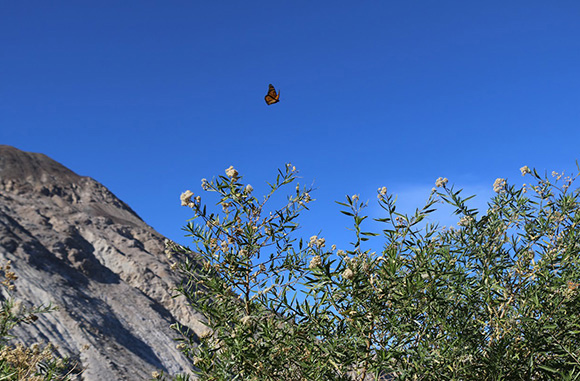
A monarch near Death Valley, California. Credit: USFWS
February 6, 2018 - Carlsbad, Calif.— The Xerces Society for Invertebrate Conservation announced this year’s western monarch population numbers on Friday, February 2, 2018. The 2017-18 count tallied fewer than 200,000 monarchs. This is the lowest number observed since 2012 and is notably down from last year, when just under 300,000 overwintering butterflies were estimated along the California coast.
Each year the Xerces Society coordinates the Western Monarch Thanksgiving Count (WMTC) encouraging volunteer citizen scientists to visit overwintering sites to count monarchs along the West Coast over a three week period. The WMTC was standardized in 1997 and data collected since then now lends itself to researchers who track the overall population of monarchs in the West.
This year, a few sites in Santa Cruz County remained stable or were slightly higher in numbers however, other major sites decreased dramatically. The volunteer effort was the highest ever recorded, with more sites surveyed this year. Scientists and volunteers noted that monarchs appeared to cluster late this winter, and it is possible that the later arrival to overwintering sites impacted the overall count. Regardless of the reason for lower numbers counted this year, there is a severe decline in the population when compared to 20 years ago when the count was initiated and approximately 1.2 million monarchs were estimated at overwintering groves along the coast.
“Volunteers for the Western Monarch Thanksgiving Count ensure we have a pulse on monarch populations in the West. Without them, this data wouldn’t be possible,” said Paul Souza, Pacific Southwest Regional Director for the U.S. Fish and Wildlife Service. “This year’s announcement underscores the importance of continued monarch and pollinator conservation, whether it’s in your own backyard, on working private lands or on our public lands.”
The U.S. Fish and Wildlife Service is working with partners across the West to ensure conservation of monarchs and pollinators through habitat restoration, education, providing support for WMTC volunteer training and development of voluntary habitat guidelines for overwintering site managers. You too can help monarchs by planting native nectar flowers and native milkweed in your garden or neighborhood.
To learn more about this year’s monarch population announcement or become a volunteer monarch monitor, visit: http://www.westernmonarchcount.org/western-monarch-butterflies-continue-to-decline/
The U.S. Fish and Wildlife Service works with others to conserve, protect, and enhance fish, wildlife, plants, and their habitats for the continuing benefit of the American people. For more information about our work and the people who make it happen, visit www.fws.gov/cno or connect with us via Facebook, Twitter, YouTube, and Flickr.
Learn More about Monarchs
Source: U.S. FWS









